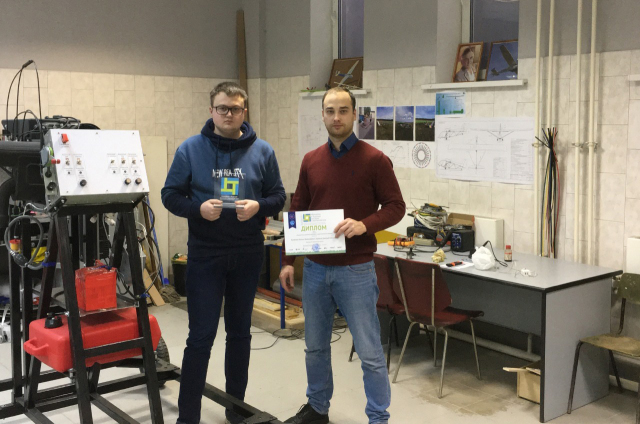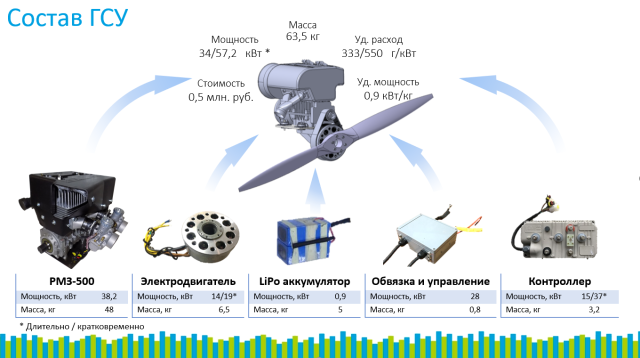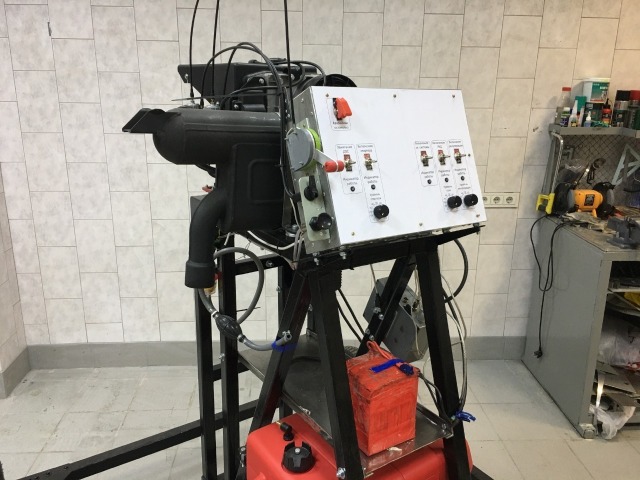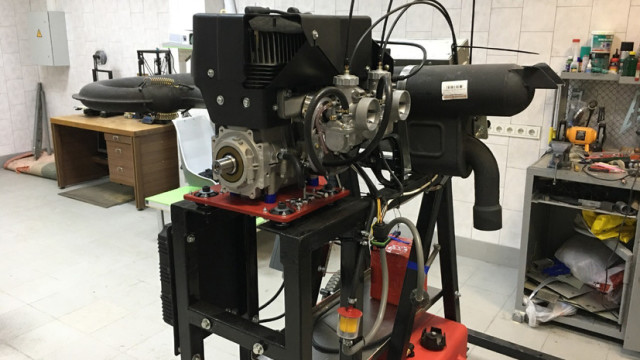In the fall of 2022, flight tests of the latest Russian hybrid engine for UAVs and light manned aircraft will begin. Kirill Balyasny, a design engineer at the Moscow Aviation Institute, said this in an interview with RT. The peculiarity of this unit is the use of internal combustion engine energy in combination with electric traction. With such a motor, aircraft with a take-off weight of up to 400-600 kg will be able to rise into the air. It is expected that in terms of specific gravity and power, the Russian hybrid will be comparable to the Austrian Rotax 912 UL unit. At the same time, the cost of the MAI engine will be significantly lower than the foreign engine.
"To create a technological reserve": the developer of the aviation "hybrid" - about the advantages of the new engine from MAI
- Projects of aviation hybrid power plants (HSU) have become a kind of technological trend all over the world. Only in Russia such titans as the Central Institute of Aviation Engine Building named after him work in this segment. Baranova (CIAM) and the United Engine Corporation (UEC). What is the specifics of the MAI project?
— Unlike other enterprises, the design team of the 203rd department creates a hybrid power plant for unmanned aircraft and light manned aircraft. This is our niche, and here, as I think, we do not enter into competition with other domestic developers. In addition, the MAI project involves the use of an internal combustion engine (ICE) in the GSU, and not a classic aviation gas turbine engine.
The idea to combine two power units — an electric motor and an internal combustion engine with a common propeller drive - came to me in the process of developing and bench testing components of an electric power plant (ESU) for an experimental single-seat electric aircraft.
The main idea of such a product is to use a piston engine with power only for horizontal flight, and to provide the necessary increase in thrust for takeoff and climb at the expense of electrical energy. Already now we have a flying demonstrator of an electric aircraft in our asset, in which part of the tasks for the development of GSU have been solved.
— When did the work on the GSU begin directly?
- Work on the hybrid power plant started at the department in May 2021 with the support of the Acting Vice-rector for Scientific Work, Doctor of Technical Sciences, Professor Yuri Ravikovich.
In November 2021, our project won first place at the XIII All-Russian intersectoral competition "Youth and the future of aviation and Cosmonautics" in the direction of "Aviation, rocket engines and power plants".
 |
| MAI design engineers Dmitry Borisov (left) and Kirill Balyasny (right). |
| Source: Personal archive of MAI Design Engineer Kirill Balyasny |
In December, the GSU project was presented to the Rector of MAI, Doctor of Technical Sciences Mikhail Poghosyan. As a result, a recommendation was received to create a line of aviation "hybrids" of various capacities for aircraft of different classes.
In addition to me, design engineer Dmitry Borisov and lead engineer Alexey Sychev are working on the GSU. We also try to involve students in the work. This is a unique opportunity for them to take part in the design and construction of aircraft, master modern production equipment, learn 3D modeling and drafting design documentation.
— What practical effect do you plan to achieve?
— There are several schemes of hybrid power plants, the most common is the use of a piston or gas turbine engine together with a generator. A traditional power unit stores energy in a battery that is connected to an electric motor with an air screw. As I have already said, we use a common drive of the internal combustion engine and the electric motor for the propeller. This makes the hybrid powerplant more compact and lightweight.
Our GSU will allow to increase the duration of the flight of aircraft (compared to purely electric ones), increase the power at take-off mode, and also reduce the cost of the power plant compared to similar internal combustion engines.
In our "hybrid", an electric motor will be connected to the operation of the internal combustion engine during take-off mode and additionally increase the power of the GSU. In a cruising flight, only the internal combustion engine will work, and the electric motor will be in recovery mode (returning energy for further use. - RT) will be able to charge a small buffer battery. Also, the electric motor in case of failure of the internal combustion engine should help the aircraft to reach the landing pad.
- Modern demonstrators (prototypes) GSU still has many shortcomings. One of them is excessive weight and size properties. After all, the aircraft should, in fact, rise into the air with two motors instead of one and also carry a battery.
- Yes, it is, but intensive work is underway all over the world to reduce the weight and size of HSU. Mathematical calculations and practical tests convincingly prove that the main advantage of aviation "hybrids" lies in the fact that they give a gain in range and duration of flight. As a result, savings in the cost of operating the aircraft are achieved, harmful emissions are reduced.
So, if a modern single-seat aircraft equipped with an electric power plant and a battery provides flight for about 25 minutes, then the "hybrid" we are creating with the same mass already allows you to stay in the air for more than an hour.
Of course, modern GSU is far from ideal. Significant progress in this area is also related to how effectively the classic engine will perform the function of a generator and how much energy the battery pack will be able to accommodate, which at the same time should remain compact and relatively light.
 |
| Technical characteristics of the GSU MAI. |
| Source: Personal archive of MAI Design Engineer Kirill Balyasny |
Naturally, all these issues are being worked out by the staff of the 203rd Department of MAI. At the current stage, it is important to complete the design and assemble the GSU demonstrator, and then determine the directions of product improvement. In the future, we expect to use batteries weighing 6-7 kg.
— Which engine will be installed in the GSU as an internal combustion engine? By what parameters did you choose the internal combustion engine?
— To carry out experimental work, a gasoline two-stroke RMZ-500 engine with a capacity of 50 hp was purchased. This is a domestic analogue of the Austrian Rotax 503 power unit. It is used on paragliders, airboats and sleds. RMZ-500 is a reliable, economical and affordable engine capable of developing the necessary thrust and giving the carrier the opportunity to maneuver.
— It's no secret that Russia is experiencing certain difficulties with equipping UAVs with its own power plants. Will there be many imported units and systems in the GSU?
— In the manufacture of prototypes, it is normal practice to widely use components available on the market, because the primary task for designers is to check the viability and adequacy of the technical solutions adopted.
I will not hide that there are foreign components in our GSU. This is an electric motor controller, various sensors, a battery cell and more. The share of imported units and systems in the product will be about 30%. But in the future, it is quite realistic to find a replacement for domestic analogues for many foreign-made components. The share of Russian elements can be increased to 85-90%.
— Do you have an idea on which devices you will mount the GSU?
— I want to remind you that modern aircraft engines are often not developed for specific carriers. In our case, we have an understanding that the "hybrid", which is being created at MAI, will be in demand in amateur aviation, that is, for installation on single and double aircraft. This market is actively developing, including in our country. For example, in Russia, single-seat aircraft with a take-off weight of less than 115 kg can fly completely freely. Many people who are passionate about aviation take advantage of this opportunity.
It will also be possible to equip aircraft-type drones with a take-off weight of up to 400-600 kg with our product. Now in Russia there are strict legal restrictions on UAV flights. Devices from 250 g to 30 kg must be registered, and they can not fly everywhere. Flights of heavier drones are, in fact, prohibited.
However, many experts are sure that drones will certainly be widely used in the Russian Federation for commercial and other purposes. In Russia, zones are being created where the mass use of UAVs, including heavy-duty ones, is being tested. For example, in the Tomsk region, it is planned to use drones weighing more than 30 kg for the delivery of heavy loads (from 0.1 to 1500 kg), aerial photography and agricultural work.
According to the Ministry of Economic Development of the Russian Federation, by the end of this year, several so-called experimental legal regimes (EPR) are planned to be launched in our country to test the possibilities of cargo and passenger transportation using drones. The widespread use of civilian drones will certainly become a reality, and, of course, UAVs will need reliable and efficient engines in operation. We can say that the staff of the 203rd department of MAI is working ahead of the curve. Now it is important to create a technological reserve, which will then allow us to improve and produce a line of "hybrids" for the needs of customers.
— At what stage is the implementation of the GSU project and when is it planned to start flight tests?
— Now the last stage of the hybrid assembly is being completed, a ground stand has already been created for its testing, the electric motor is being tested, which has become more powerful, the gearbox is practically manufactured.
Tests will begin soon. During them, the control system will first be checked (both separately and as part of the GSU). It must provide synchronous operation of the internal combustion engine and the electric motor. Then the power bench tests of the hybrid will start. In the fall of 2022, we plan to conduct flight tests on a demonstrator aircraft.
 |
| Demonstrator of the aviation GSU MAI. |
| Source: Personal archive of MAI Design Engineer Kirill Balyasny |
In addition to the GSU, a distributed power plant is being created — these are several small electric motors with propellers that are placed along the leading edge of the wing and create additional lifting force. At the same time, their nutrition is provided by the marching GSU. Such a product, from our point of view, will be required for aircraft with a shortened takeoff and landing.
According to the calculations we have carried out, our engine will be comparable in specific gravity and power to the Austrian Rotax 912 UL engine, but it will be almost three times cheaper.
Negotiations are underway with potential customers interested in our project. We evaluate their requirements and our capabilities to establish the production of "hybrids".
Alexey Zakvasin

